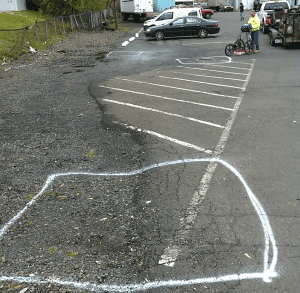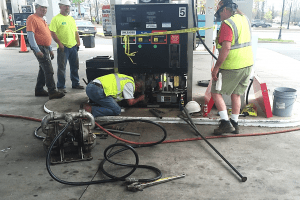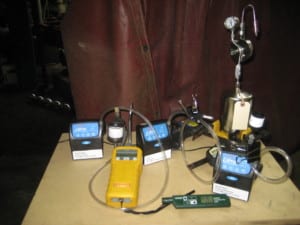 A Phase I Environmental Site Assessment (ESA) was prepared for a property and the report identified a Recognized Environmental Condition (REC) and recommends a Phase II Environmental Site Assessment. Does that mean the property has an environmental liability and an expensive problem? The value of an environmentally-impacted property can be greatly reduced by the cost of a potential cleanup. In fact, the cleanup liability could be even greater than the value of the property. In this article, you will learn about RECs and how they are characterized during a Phase II ESA–they may impact your decision to continue with a property transaction.
A Phase I Environmental Site Assessment (ESA) was prepared for a property and the report identified a Recognized Environmental Condition (REC) and recommends a Phase II Environmental Site Assessment. Does that mean the property has an environmental liability and an expensive problem? The value of an environmentally-impacted property can be greatly reduced by the cost of a potential cleanup. In fact, the cleanup liability could be even greater than the value of the property. In this article, you will learn about RECs and how they are characterized during a Phase II ESA–they may impact your decision to continue with a property transaction.
What is a Recognized Environmental Condition?
A REC is defined as the presence or likely presence of any hazardous substances or petroleum products in, on, or at a property. A REC doesn’t necessarily mean that there is contamination, just that it is possible.
Once a REC is identified in a Phase I ESA, a Phase II ESA may be recommended to evaluate the RECs by using sampling data to confirm the presence or threat of a release to the environment.
Phase II Environmental Site Assessment
No two Phase II ESAs are alike because not all properties are the same and not all facilities have the same RECs.
What all Phase II ESAs have in common is that they include sampling and laboratory analysis to confirm the presence or absence of hazardous materials or petroleum. Some of the tests that may be performed include:
 Collection of surficial soil and water samples
Collection of surficial soil and water samples
An example where this type of sampling would be conducted is where there was an oil stain on the soil or a sheen on a puddle of water. Field testing equipment is used to provide an initial indication of the presence or absence of contamination, which can be followed by the submittal of samples for laboratory analysis to determine if the soil or water quality complies with state and/or Federal standards.
 Collection of subsurface soil borings
Collection of subsurface soil borings
Where there is a possibility for soil contamination to extend below the surface, drilling equipment is utilized to collect soil samples from greater depths (i.e., the subsurface).
Field testing equipment is used to provide an initial indication of the presence or absence of contamination and samples are also submitted for laboratory analysis to determine if the soil meets state and/or Federal standards.
Groundwater monitoring well installation, sampling, and analysis
Where there is a possibility for groundwater contamination (an example would be a history of old underground storage tanks on the property), drilling equipment is utilized to install monitoring wells.
Soil samples are collected during drilling and groundwater samples are collected once the wells are installed. The soil and water samples are submitted for laboratory analysis to ascertain if they are in compliance with state and/or Federal standards.
Drum sampling
Unmarked drums can constitute a REC. Sampling and analysis of the contents of the drum is used to properly characterize the material and determine the proper disposal process.
Sampling of dry wells, floor drains, and catch basins
Dry wells, floor drains, and catch basins may provide an avenue for environmental impact. Materials in these structures and/or from their outfalls are sampled and submitted for laboratory analysis to determine if they conform to state and/or Federal standards.
 Transformer/capacitor sampling for Polychlorinated Biphenyls (PCBs)
Transformer/capacitor sampling for Polychlorinated Biphenyls (PCBs)
Old transformers formerly contained PCB oil. Transformers that are not labeled as not containing PCBs are suspect. Sampling is conducted to confirm the type or to confirm the presence or absence of PCBs.
 Geophysical testing for buried tanks and drums
Geophysical testing for buried tanks and drums
Geophysical testing can be used to locate buried tanks or drums.
Grids are set up and the equipment is passed over the ground to identify possible areas of metal or disturbed soil.
 Soil excavation to determine presence of buried tanks or waste
Soil excavation to determine presence of buried tanks or waste
Areas marked by geophysical testing or areas suspected of containing buried waste or tanks may be investigated by excavating test pits.
Test pits may expose tanks or drums and also provide a means for accessing soil and waste samples for laboratory analysis.
 Testing of underground storage tanks
Testing of underground storage tanks
Operational storage tanks are tested to confirm integrity. Permits, previous test records, and inventory records are reviewed for evidence of leaks or discharges.
Tank pit monitoring wells are sampled and analyzed.
The interstitial monitoring points in the tank system are also examined for the presence of leaks.
 Indoor air quality sampling
Indoor air quality sampling
The presence of chemicals, presence of mold, and potential presence of soil contamination can impact indoor air quality. Air samples can be collected for biological and chemical analysis. Biological testing is compared to outdoor ambient conditions while chemical analytical results are compared to indoor air quality health standards.
Limited Phase II ESA vs. a Comprehensive Phase II ESA
Above we discussed how the purpose of a Phase II ESA is to confirm the presence of a REC. A limited Phase II is sampling necessary just to confirm the presence of a pollutant.
A comprehensive Phase II ESA includes extensive sampling to fully characterize the extent of contamination and analysis of potential migration pathways and potential receptors so that cleanup costs can be estimated.
A common procedure is for a buyer to conduct a limited Phase II ESA to make the following decisions:
- The REC is minor or inconsequential
- The REC is confirmed and may pose more of a risk than the buyer is willing to accept
- The REC is confirmed and more study is needed to quantify the extent of pollutants discovered in order to make an appropriate decision
If decision 3 is selected, a follow-up Comprehensive Phase II ESA would be conducted.
Example of the Phase II Decision Process on a Recent Property Transaction
A buyer had a Phase I ESA performed on a commercial property. The Phase I identified two RECs on the property:
- the property formerly had an underground waste oil storage tank
- the property contained a building that was used as a machine shop and the shop floor drains connected to an on-site French drain.
The Limited Phase II included:
- Underground tank area
- 2-3 soil borings in the area of the former underground tank
- Field screening of soil samples for volatile organic compounds (VOCs)
- Laboratory analysis of stained soil samples and/or highest field screening result. Analysis included volatile and semi-volatile petroleum hydrocarbon compounds and heavy metals.
- Installation of groundwater monitoring points or wells
- Collection of groundwater samples for laboratory analysis of volatile and semi-volatile petroleum hydrocarbon compounds and heavy metals.
- Comparison of all laboratory analytical results to applicable state and Federal standards
- French drain area
- 2-3 soil borings in the area of the French drain
- Field screening of soil samples for VOCs
- Laboratory analysis of stained soil samples and/or highest field screening. Analysis included volatile and semi-volatile petroleum hydrocarbon compounds, chlorinated solvents, and heavy metals.
- Installation of groundwater monitoring points or wells
- Collection of groundwater samples for laboratory analysis of volatile and semi-volatile petroleum hydrocarbon compounds, chlorinated solvents, and heavy metals.
- Comparison of all laboratory analytical results to applicable state and Federal standards.
Based upon the results of the Limited Phase II ESA, the buyer elected to proceed with a comprehensive Phase II ESA that included:
- Additional borings and soil samples to fully characterize the areal extent of soil contamination identified in the area of the underground tank. Sample analysis was limited to the compounds identified in the Limited Phase II.
- Additional borings and soil samples to fully characterize the areal extent of soil contamination identified in the area of the French drain. Sample analysis was limited to the compounds identified in the Limited Phase II, which were different than the compounds detected in the area of the UST.
- Installation of additional monitoring wells and collection of groundwater samples to fully determine the extent of groundwater contamination. In this case, the groundwater contaminant plumes were commingled and the analysis consisted of the entire suite of chemicals previously detected in the Limited Phase II ESA.
- Determination of groundwater flow direction
- Evaluation of potential migration pathways for accumulation of hazardous concentrations of soil vapor
- Evaluation of potential down-gradient groundwater receptors
In this case, the buyer concluded there was sufficient information to determine that the cost of a cleanup was worth the discounted price of the property. He also determined that cleanup activities would not prohibit development of the property and that there was adequate documentation to present for regulatory approval of the assessment and cleanup of the property.
Contact Ambipar Response EMS to learn more about how we can help you with your Phase I and Phase II ESA needs.

For more information about Phase I Environmental Site Assessments, check out these articles:
How Much Does a Phase I Environmental Site Assessment Cost?
What are the Qualifications of a Phase I ESA Provider?
Is a Phase I ESA Necessary for Every Commercial Property Purchase?
For more information about Phase II Environmental Site Assessments, please read:
How Much Does a Phase II Environmental Site Assessment Cost?
Why Property Sellers Should Conduct Phase II Environmental Site Assessments


